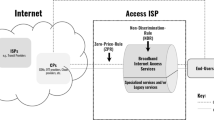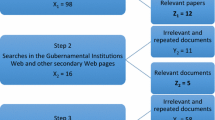Abstract
Next generation access networks will be critical for future economic growth and access to these infrastructures will have major consequences for territorial and social cohesion. This paper examines the economic and competition determinants that serve as incentives for operators to invest in fiber-to-the-home technology. We draw on a dataset comprising 6603 Spanish municipalities with access to broadband services to examine the incumbent’s (Telefónica) deployment of fiber in the period 2010–2013. We show that local loop unbundling competition had a strong positive impact on Telefónica’s fiber deployment, while bitstream competition had a negative effect. Moreover, the incumbent was more likely to invest in municipalities with a large presence of cable operators. We also consider how the municipalities’ sociodemographic characteristics affected the operator’s deployment decision. While market size and population density had a positive effect on investment, the level of unemployment and the percentage of elderly population had a negative impact.

Source: CNMC

Source: CNMC
Similar content being viewed by others
Notes
There are three types of NGA broadband: VDSL over copper (with a network topology known as FTTN/FTTC), FTTP (comprises both fiber to the home—FTTH—and fiber to the building—FTTB) and coaxial cable networks upgraded by the standard DOCSIS 3.0. These networks vary on the distance between the fiber end and the consumer’s premises. For example, in Spain, Portugal and France, the fiber reaches the customer’s home (FTTH), whilst in the UK, Germany and Belgium the fiber reaches a street cabinet (FTTC) from which a copper cable provides access (BEREC 2016, p. 21).
The EC Communication “Connectivity for a Competitive Digital Single Market—Towards a European Gigabit Society” states that by 2025, symmetrical connectivity must be provided at 1 Gb per second in strategic locations (public infrastructure and industrial areas), that there should be complete 5G coverage in urban centers and on main transport routes, and that all households should have Internet at speeds of at least 100 Mbps. In addition, the EC proposes a reform of the regulatory framework for electronic communications and suggests the creation of a European Broadband Fund.
In Spain, the regulation of the local loop was established in 1999 and the EC recommended it in its Directives in 2001 (Calzada and Costas 2016).
The “ladder-of-investment” approach was initially described by Cave (2006).
Another strand in the literature uses country-level data to analyze broadband diffusion. Some papers discuss the relevance of inter- and intra-platform competition (Distaso et al. 2006; Lee and Brown 2008; Bouckaert et al. 2010; Gruber and Koutroumpis 2013; Briglauer 2014; Ovington et al. 2017). See a review of the literature in Briglauer et al. (2014). Other papers use microdata to analyze broadband diffusion (Dauvin and Grzybowski 2014; Nardotto et al. 2015).
According to BEREC (2016), civil infrastructure works can constitute up to 70–80% of the cost of deploying this technology.
Bitstream prices were the same in all the period of analysis, but the LLU price rose from 7.79 to 8.32 euros in February 2011.
See pages 14–16 in CMT’s “Report about the revision of some prices of the reference offers on the basis of Telefónica’s audited 2008 accounts” (DT 2010/1275).
These were Telefónica, Vodafone, Jazztel, Orange, Ono, R, Telecable and Euskaltel. At the start of the period of analysis in 2010, these operators accounted for 97.5% of the national broadband market.
In the period we analyze there were no fiber exits in Spain and therefore it is not possible to identify sunk entry costs by comparing entry and exit thresholds, as suggested by Bresnahan and Reiss (1994). Such dynamic entry models have been used by Xiao and Orazem (2011), Nardotto et al. (2015) and Bourreau et al. (2017) to analyze LLU entry.
Note that as the probability of fiber deployment (Pi) is so low, the odds are similar to the probability and the odds ratio is similar to the probability ratio.
Duso et al. (2017) examine the impact of national state aid schemes in Germany and of some regional programs. They show that the aid schemes were successful and did not impair competition.
For the FTTH market share, see CNMC’s quarterly data at data.cnmc.es. The source for the household coverage is the EC’s Europe’s Digital Progress Report, 2016.
This reform eliminated the 30 Mbps limit for access to Telefónica’s network.
References
Bacache, M., Bourreau, M., & Gaudin, G. (2014). Dynamic entry and investment in new infrastructures: Empirical evidence from the fixed broadband industry. Review of Industrial Organization, 44(2), 179–209.
BEREC. (2016). Challenges and drivers of NGA rollout and infrastructure competition. Body of European Regulators for Electronic Communications, BoR, 16, 171.
Bouckaert, J., Van Dijk, T., & Verboven, F. (2010). Access regulation, competition, and broadband penetration: An international study. Telecommunications Policy, 34, 661–671.
Bourreau, M., Cambini, C., & Dogan, P. (2012). Access pricing, competition, and incentives to migrate from “old” to “new” technology. International Journal of Industrial Organization, 30(6), 713–723.
Bourreau, M., Cambini, C., & Dogan, P. (2014). Access regulation and the transition from cooper to fiber networks in telecoms. Journal of Regulatory Economics, 45(3), 233–258.
Bourreau, M., Grzybowski, L., & Hasbi, M. (2017). Private operators’ entry in the FttH Market—The case of France, mimeo.
Bresnahan, T., & Reiss, P. (1994). Measuring the importance of sunk costs. Annales d’ Economie et de Statistique, 31, 181–217.
Briglauer, W. (2014). The impact of regulation and competition on the adoption of fiber based broadband services: Recent evidence from the European Union member states. Journal of Regulatory Economics, 46, 51–79.
Briglauer, W. (2015). How EU sector specific regulations and competition affect migration from old to new communications infrastructure. Recent evidence from EU27 member states. Journal of Regulatory Economics, 48, 194–217.
Briglauer, W., Cambini, C., & Melani, S. (2016). How to fill the digital gap? The (limited) role of regulation, ZEW Discussion Papers, No. 16-002.
Briglauer, W., Ecker, G., & Gugler, K. (2013). The impact of infrastructure and service-based competition on the deployment of next generation access networks: Recent evidence from the European member states. Information Economics and Policy, 25(3), 201–223.
Briglauer, W., Frübing, S., & Vogelsang, I. (2014). The impact of alternative public policies on the deployment of new communications infrastructure—Survey. Review of Network Economics, 13(3), 227–270.
Briglauer, W., & Vogelsang, I. (2011). The need for a new approach to regulating fixed networks. Telecommunications Policy, 35(2), 102–114.
Brito, D., Pereira, P., & Vareda, J. (2010). Can two-part tariffs promote efficient investment on next generation networks? Information Economics and Policy, 24(3), 197–211.
Calzada, J., & Costas, A. (2016). La liberalización de las telecomunicaciones en España: Control de la inflación y universalización del servicio. Revista de Historia Industrial, 63, 161–204.
Cave, M. (2006). Encouraging infrastructure competition via the ladder of investment. Telecommunications Policy, 30, 223–237.
Dauvin, M., & Grzybowski, L. (2014). Estimating broadband diffusion in the EU using NUTS1 regional data. Telecommunications Policy, 38(1), 96–104.
Distaso, W., Lupi, P., & Manenti, F. M. (2006). Platform competition and broadband uptake: Theory and empirical evidence from the European Union. Information Economics and Policy, 18, 87–106.
Duso, T., Nardotto, M., & Seldeslachts, J. (2017). A retrospective study of state aid control in the German Broadband market, mimeo.
Economides, N., Seim, K., & Viard, V. B. (2008). Quantifying the benefits of entry into local phone service. Rand Journal of Economics, 39, 699–730.
Fabritz, N., & Falck, O. (2013). Investment in broadband infrastructure under local deregulation: Evidence from the UK broadband market, mimeo.
García-Mariñoso, B., & Suárez, D. (2013). The determinants of broadband demand in Spain: Digital divide. Papeles de Economía Española, 136, 131–139.
Grajek, M., & Röller, L. M. (2012). Regulation and investment in network industries: Evidence from European Telecoms. The Journal of Law and Economics, 55(1), 189–216.
Greenstein, S., & Mazzeo, M. (2006). The role of differentiation strategy in local telecommunication entry and market evolution: 1999–2002. Journal of Industrial Economics, 54, 323–350.
Gruber, H., & Koutroumpis, P. (2013). Competition enhancing regulation and diffusion of innovation: The case of broadband networks. Journal of Regulatory Economics, 43, 168–195.
Hausman, J., & Sidak, G. (2005). Did mandatory unbundling achieve its purpose? Empirical evidence from five countries. Journal of Competition Law and Economics, 1(1), 173–245.
Hazlett, T., & Bazelon, C. (2005). Regulated unbundling of telecommunications networks: A stepping stone to facilities-based competition, mimeo.
Inderst, R., & Peitz, M. (2014). Investment under uncertainty and regulation of new access networks. Information Economics and Policy, 26(3), 28–41.
Lee, S., & Brown, J. S. (2008). Examining broadband adoption factors: An empirical analysis between countries. Info, 10(1), 25–39.
Minamihashi, N. (2012). Natural monopoly and distorted competition: Evidence from unbundling fiber-optic network. Bank of Canada Working Paper 2012-06.
Nardotto, M., Valletti, T., & Verboven, F. (2015). Unbundling the incumbent: Evidence from UK broadband. Journal of the European Economic Association, 13(2), 330–362.
Nitsche, R., & Wiethaus, L. (2011). Access regulation and investment in next generation networks—A ranking of regulatory regimes. International Journal of Industrial Organization, 29(2), 263–272.
Ovington, T., Smith, R., Santamaría, J., & Stammati, L. (2017). The impact of intra-platform competition on broadband penetration. Telecommunications Policy, 41(3), 185–196.
Prieger, J. A., Malnor, G., & Savage, S. (2015). Quality competition in the broadband service provision industry, mimeo.
Suárez, D., & García-Mariñoso, B. (2013). Which are the drivers of fixed to mobile telephone access substitution? An empirical study of the Spanish residential market. Telecommunications Policy, 37, 282–291.
Xiao, M., & Orazem, P. (2009). Is your neighbor your enemy? Strategic entry into the US Broadband Market, mimeo.
Xiao, M., & Orazem, P. (2011). Does the fourth entrant make any difference? Entry and competition in the early US broadband market. International Journal of Industrial Organization, 29, 547–561.
Acknowledgements
We thank Mattia Nardotto and Lukasz Grzybowski for their valuable comments and suggestions. Joan Calzada acknowledges financial support from the Spanish Ministry of Economy and Competitiveness (ECO2015- 69193R). The opinions and analysis that appear in this paper are responsibility of the authors only and do not necessarily represent those of the CNMC.
Author information
Authors and Affiliations
Corresponding author
Rights and permissions
About this article
Cite this article
Calzada, J., García-Mariñoso, B., Ribé, J. et al. Fiber deployment in Spain. J Regul Econ 53, 256–274 (2018). https://doi.org/10.1007/s11149-018-9357-y
Published:
Issue Date:
DOI: https://doi.org/10.1007/s11149-018-9357-y




